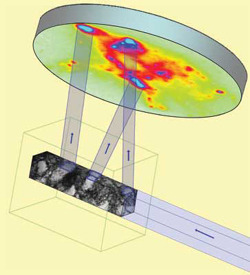The application of intense submicron-sized x-ray beams at the XOR/UNI beamlines 33-BM and 34-ID at the Advanced Photon Source (APS) has made possible the discovery that deformed metals have large, variable internal stresses in opposing directions on very short (submicron or nanoscale) length scales. This result has profound implications for understanding the mechanical strength and behavior of metals. The presence of such counterbalanced stresses within microscopic volumes (or cells) in deformed materials was predicted more than two decades ago and has been inferred from numerous indirect experiments. Yet, direct proof of their existence has been elusive, as spatially-resolved measurements of the stress magnitudes and distributions critical for testing theories and computer models were not possible before the development of high-resolution x-ray microbeams at third-generation synchrotron sources.
The results of this work are of direct relevance to important practical problems such as sheet metal forming (for example, in automobile production) and metal fatigue, the latter being responsible for most structural materials failures.
(This work is complementary to recent studies carried out at the APS by a group from Risø National Laboratory, in Denmark, and Argonne National Laboratory. In that study [Jakobsen et al., Science 312 (5775) 889-892 (12 May 2006) doi : 10.1126/ science.1124141] the group studied the earliest evolution of dislocation structures during deformation of single-crystal copper. In this work, the high spatial resolution allowed the identification of individual dislocation cells in a highly deformed single-crystal sample, which made it possible to measure local elastic strains and thus the stresses).
Contact: Lyle E. Levine (National Institute of Standards and Technology) [email protected]
See: Lyle E. Levine, Bennett C. Larson, Wenge Yang, Michael E. Kassner, Jonathan Z. Tischler, Michael A. Delos-Reyes, Richard J. Fields, and Wenjun Liu, “X-ray microbeam measurements of individual dislocation cell elastic strains in deformed single-crystal copper,” Nat. Mater. online (16 July 2006) doi: 10.1038/nmat1698.
This work supported by the U.S. Department of Energy’s (DOE’s) Office of Basic Energy Sciences (BES). Research at ORNL is supported by the BES Division of Materials Sciences under contract with UT-Battelle, LLC. The XOR-UNI facilities on sectors 33 and 34 at the APS are supported by the DOE Office of Science. Use of the Advanced Photon Source was supported by the U. S. Department of Energy, Office of Science, Office of Basic Energy Sciences, under Contract No. W-31-109-ENG-38.
Argonne National Laboratory is a U.S. Department of Energy laboratory managed by The University of Chicago.

